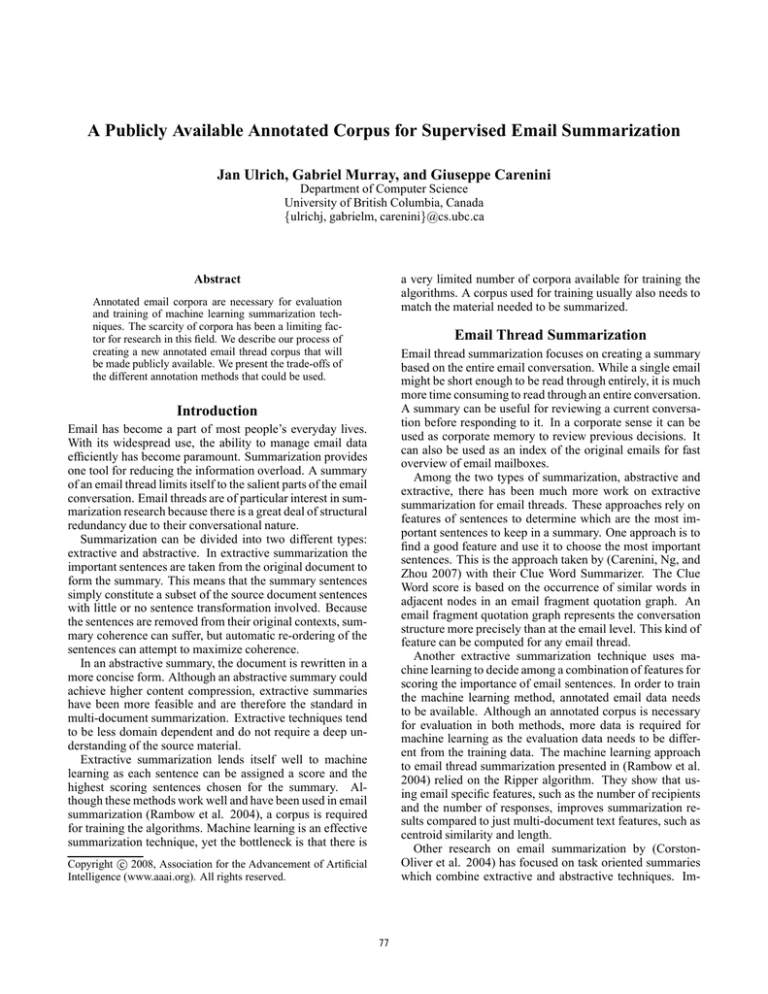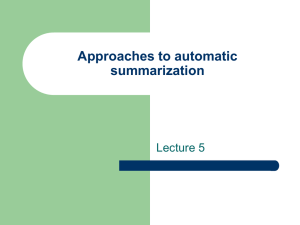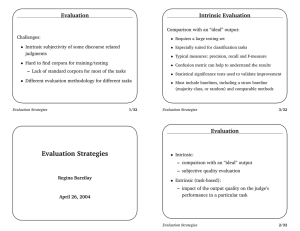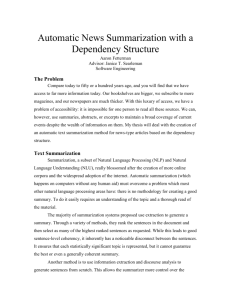
A Publicly Available Annotated Corpus for Supervised Email Summarization
Jan Ulrich, Gabriel Murray, and Giuseppe Carenini
Department of Computer Science
University of British Columbia, Canada
{ulrichj, gabrielm, carenini}@cs.ubc.ca
a very limited number of corpora available for training the
algorithms. A corpus used for training usually also needs to
match the material needed to be summarized.
Abstract
Annotated email corpora are necessary for evaluation
and training of machine learning summarization techniques. The scarcity of corpora has been a limiting factor for research in this field. We describe our process of
creating a new annotated email thread corpus that will
be made publicly available. We present the trade-offs of
the different annotation methods that could be used.
Email Thread Summarization
Email thread summarization focuses on creating a summary
based on the entire email conversation. While a single email
might be short enough to be read through entirely, it is much
more time consuming to read through an entire conversation.
A summary can be useful for reviewing a current conversation before responding to it. In a corporate sense it can be
used as corporate memory to review previous decisions. It
can also be used as an index of the original emails for fast
overview of email mailboxes.
Among the two types of summarization, abstractive and
extractive, there has been much more work on extractive
summarization for email threads. These approaches rely on
features of sentences to determine which are the most important sentences to keep in a summary. One approach is to
find a good feature and use it to choose the most important
sentences. This is the approach taken by (Carenini, Ng, and
Zhou 2007) with their Clue Word Summarizer. The Clue
Word score is based on the occurrence of similar words in
adjacent nodes in an email fragment quotation graph. An
email fragment quotation graph represents the conversation
structure more precisely than at the email level. This kind of
feature can be computed for any email thread.
Another extractive summarization technique uses machine learning to decide among a combination of features for
scoring the importance of email sentences. In order to train
the machine learning method, annotated email data needs
to be available. Although an annotated corpus is necessary
for evaluation in both methods, more data is required for
machine learning as the evaluation data needs to be different from the training data. The machine learning approach
to email thread summarization presented in (Rambow et al.
2004) relied on the Ripper algorithm. They show that using email specific features, such as the number of recipients
and the number of responses, improves summarization results compared to just multi-document text features, such as
centroid similarity and length.
Other research on email summarization by (CorstonOliver et al. 2004) has focused on task oriented summaries
which combine extractive and abstractive techniques. Im-
Introduction
Email has become a part of most people’s everyday lives.
With its widespread use, the ability to manage email data
efficiently has become paramount. Summarization provides
one tool for reducing the information overload. A summary
of an email thread limits itself to the salient parts of the email
conversation. Email threads are of particular interest in summarization research because there is a great deal of structural
redundancy due to their conversational nature.
Summarization can be divided into two different types:
extractive and abstractive. In extractive summarization the
important sentences are taken from the original document to
form the summary. This means that the summary sentences
simply constitute a subset of the source document sentences
with little or no sentence transformation involved. Because
the sentences are removed from their original contexts, summary coherence can suffer, but automatic re-ordering of the
sentences can attempt to maximize coherence.
In an abstractive summary, the document is rewritten in a
more concise form. Although an abstractive summary could
achieve higher content compression, extractive summaries
have been more feasible and are therefore the standard in
multi-document summarization. Extractive techniques tend
to be less domain dependent and do not require a deep understanding of the source material.
Extractive summarization lends itself well to machine
learning as each sentence can be assigned a score and the
highest scoring sentences chosen for the summary. Although these methods work well and have been used in email
summarization (Rambow et al. 2004), a corpus is required
for training the algorithms. Machine learning is an effective
summarization technique, yet the bottleneck is that there is
c 2008, Association for the Advancement of Artificial
Copyright Intelligence (www.aaai.org). All rights reserved.
77
are more than 50,000 threads in total. W3C data has been annotated for QA topic relevance for use in TREC Enterprise
2005 and 2006.
portant sentences were extracted using an SVM and then reformulated into a task oriented imperative. In this way tasks
could automatically be populated into the Outlook ”to-do”
list.
The CSIRO Corpus Subsequent to TREC 2006, TREC
Enterprise began using similar data from the Australian organization CSIRO. Because the QA topics and relevance annotations were drawn up by CSIRO employees themselves
rather than by outside annotators, this dataset and annotation
together represent more realistic information needs.
The main drawback of both the W3C and CSIRO corpora
for summarization annotation purposes is that the content
of the data can be quite technical, posing a problem for annotators unfamiliar with the organizations and the subjects
discussed in the data. However, there is a sufficient number
of emails in each corpus that the data could be filtered to
create corpora subsets comprised of less technical emails.
Summarizing mailing lists can also be considered to be a
slightly different task than summarizing emails from a user’s
inbox. In the latter case there will be missing or hidden data
that can sometimes be reconstructed, while this is much less
of an issue with a mailing list.
The Need For an Annotated Corpus
While researchers ideally want to work with realistic,
naturally-occurring data, privacy concerns mean that large
collections of real email data cannot typically be shared.
This has left the field with each project training and testing
new approaches on its own dataset. With this lack of large
research datasets comes the risk of overfitting algorithms to
the limited data. We believe that a publicly available email
corpus, complete with summarization annotations for training and evaluation purposes, would greatly benefit the research community. The more public benchmarks are available, the easier it is to compare diverging approaches to the
summarization task. Here we present our current email annotation project, describing the data used, the annotation
scheme employed, and the details of the user study.
Available Email Corpora
PW Calo Corpus
Below we describe several relevant datasets that are publicly
available, and assess their suitability for further annotation
and research.
As part of the CALO project2 , an email corpus was gathered during a four-day exercise at SRI, in which project participants took part in role-playing exercises and group activities. The resultant PW Calo corpus (Cohen, Carvalho,
and Mitchell 2004) totals 222 email messages. The dataset
also includes correlated meeting recordings, but currently
the corpus is not freely available.
The Enron Corpus
The most popular email corpus for research has been the Enron dataset (Klimt and Y.Yang 2004), which was released
during the legal investigation into the Enron corporation.
This is an invaluable dataset since it contains uncensored
messages from a corporate environment. Because this corpus consists of real, unaltered data, there were initially integrity problems that needed to be fixed. The dataset contains over 30,000 threads, but they end up being rather short
with an average thread size of just over four and a median of
two. The dataset consists of employee’s email folders, so it
is also an accurate depiction of how users use folders.
Previous Email Thread Annotations
The Enron corpus has previously been annotated for summarization (Carenini, Ng, and Zhou 2007). A subset of threads
were selected, and important sentences were ranked by annotators in a user study. Each thread was summarized (using
extraction) by 5 annotators which were asked to select 30%
of the original number of sentences and label them as essential or optional. Each sentence was then given an overall
importance score based on the combined annotations. An essential sentence carried three times the weight of an optional
sentence. Using several annotators is assumed to produce a
more meaningful result by diminishing the effect of individual differences. 39 threads were annotated in this way to
produce a corpus for evaluation.
This annotation is targeted towards extractive summarization and it is hard to use with an abstractive summarization
technique. It also has several arbitrary restrictions including the requirement of 30% sentence selection as well as
only two choices for sentence importance. The weight of an
essential sentence compared to an optional sentence is also
arbitrary. Annotators might have a different conception of
what is an optional sentence and an essential sentence. However the annotator’s directions are straight-forward and the
annotation of selecting sentences is easier for the annotator
than writing a summary from scratch.
TREC Enterprise Data
In the TREC Enterprise Track1 , the task is to search through
an organization’s multimodal data in order to satisfy a given
information need. Organizations often possess a great variety of data, from emails to web pages to spreadsheets
and word documents. Being able to search, summarize and
link these documents can greatly aid corporate memory. In
recent years, TREC Enterprise has used two multimodal
datasets for Question-Answer (QA) tasks.
The W3C Corpus The W3C corpus is data derived from a
crawl of the World Wide Web Consortium’s sites at w3c.org.
The data include mailing lists, public webpages, and text
derived from .pdf, .doc and .ppt files, among other types.
The mailing list subset is comprised of nearly 200,000 documents, and TREC participants have provided thread structure based on reply-to relations and subject overlap. There
1
2
http://www.ins.cwi.nl/projects/trec-ent/
78
http://caloproject.sri.com
Annotation Uses
Meta Sentences
In work on automatic summarization of meeting speech,
Murray and Renals (Murray and Renals to appear 2008)
made use of meta comments within meetings. Meta comments are cases where a speaker is referring explicitly to the
meeting itself or to the discussion itself, e.g. “So we’ve decided on the user interface.” They found that including these
comments in meeting summaries improved summary quality
according to several metrics. In order to see if a similar benefit can be found in email summarization, we have enlisted
our annotators to label sentences as meta or non-meta, where
a meta sentence refers explicitly to the email discussion itself. We hypothesize that the detection of such sentences
may aid the coherence of our extractive summaries.
For email summarization the annotation of an email thread
is a thread summary. This summary is the model for a summarization technique and is used to evaluate different algorithms. One evaluation technique, called ROUGE (Lin and
Hovy 2003), compares the n-gram overlap between the produced summary and the model summary. This is a bag of
words approach which does not tell much about the coherence of the summary, but has been useful in multi-document
summarization and is fast and easy to compute.
One well-known issue with annotation is that annotators
often do not agree on the same annotation, reflecting the fact
that there is no single best summary for a given source document. The solution is to use multiple annotators and combine their annotation. This has been done in the pyramids
method (Nenkova, Passonneau, and McKeown 2007) where
a proposed summary is evaluated based on the occurrence
of summarization content units. Summary content units are
parts of a sentence that express one idea.
Similarly, one can calculate weighted f-score (Murray and
Renals 2007) using multiple extractive gold-standard summaries. The motivating idea for this metric is that a good
machine summary might contain certain sentences from one
gold-standard, other sentences from a second gold-standard,
and so on.
Annotation is not only needed for evaluation, but is also
useful for creating the actual summarization algorithm. Labeled email threads can be used as training for machine
learning methods. Typically, the more data is available, the
better result the algorithms achieve. The work of (CorstonOliver et al. 2004) and (Rambow et al. 2004) are two examples of using annotated email thread corpora to train summarization algorithms.
Speech Acts
Emails are a modern form of communication. Compared
with online messengers or blogs, email is a more formal
communication method. When people use email, they usually have a specific purpose in mind. This specific purpose
is often shrouded in small talk to make a request less direct.
In summarization the specific purpose of an email is the important part. We therefore annotate sentences based on their
speech act. Previous work has classified an entire email into
a specific speech act (Carvalho and Cohen 2005). However
a more detailed annotation at the sentence level is useful for
summarization. In the original work, emails were classified
as Propose, Request, Commit, Deliver, Meeting, and deliveredData. These categories are not mutually exclusive. We
propose to use a subset of these speech acts which can not be
computed automatically and are information rich. The annotation would consist of the following categories: Propose,
Request, Commit, Agreement/Disagreement and Meeting. A
Propose message proposes a joint activity; a Request asks
the recipient to perform an activity; a Commit message commits the sender to some future course of action; an Agreement/Disagreement is an agreement or disagreement with a
joint activity; and a Meeting message is regarding a joint activity in time or space. Deliver is excluded because most
emails deliver some sort of information and deliveredData
is excluded because attachments or hyperlinks can be automatically parsed from an email message.
The order of these annotations also becomes interesting
in summarization, as seen in (Carvalho and Cohen 2005).
If a request is chosen as an important sentence then the
corresponding commit should also be included in the
summary. This sequential relationship can be obtained from
the email ordering in the threads.
Our Proposed Annotation
Abstractive summarization is the goal of many researchers
since it is what people do naturally. However extractive summarization has been more successful and effective since it is
easier to compute. A key goal is to successfully combine
extraction with abstraction. In order to do this a corpus is
needed that supports such a goal.
In our annotation effort we ask the annotator not only to
select the most important sentences from the original text
but also to write an abstractive summary of the thread. Links
are then formed between each human written sentence and
corresponding extracted sentences containing the same information. Extracted sentences can then be weighed by the
number of times that they are linked. It also shows the transformation of each idea from the original text to the corresponding summary sentence. By having to form these links
after the summary was written, it makes the annotator justify
both their extractive choices as well as their written summary. Such an annotation approach has been used in the
ICSI (Janin et al. 2003) and AMI (Carletta et al. 2005) corpora in meeting summarization (Murray et al. 2006).
We also propose to annotate several features which will
hopefully be useful in machine learning summarization techniques.
We are also considering annotating sentences according
to subjectivity.
The W3C Corpus Data
We decided to use the W3C corpus for our summarization
annotation project. A central reason for choosing this data
is that, even though we are annotating only a small portion
of the mailing list threads, having a very large amount of
related but unannotated data could prove very beneficial for
79
rized. This database of emails can then be used to run annotation studies. The researcher selects which threads should
be summarized by the current annotator and then starts the
annotation study. Now the researcher is logged out of the
web application for security purposes and the annotator can
take over to perform the annotation. The results are stored in
an MySQL database which can transform the results to the
format needed by the researcher. The researcher can also
log in and view past results from previous annotators. The
interface therefore allows for complete control over the annotation process.
The Annotation Study
In our study we plan to annotate the 30 threads we have selected from the W3C corpus. Each thread will be annotated
by three different annotators to reduce overall subjectivity.
The annotation study will be run on individual computer stations and annotators will be supervised by researchers. The
study consists of two steps: a summarization step consisting
of both abstractive and extractive summarization followed
by a feature collection step.
First the annotator is asked to fill out a profile of their
personal information and given instructions on how to annotate. An example is provided to go through all the annotation steps before the annotator starts with annotating actual threads. The annotation starts with the email thread being displayed allowing each email to be collapsed for navigational ease. The annotator is expected to read the entire email conversation to become familiar with the content.
The threads are also provided as a hard copy for reference
and to make notes. In the first stage annotators are asked to
write a 250 word summary describing the information contained in the email. This summary length is chosen because
it matches the length of the DUC2007 human written model
summaries in the main summarization task. Then each sentence in the written summary has to be linked to at least one
original sentence with the same content. The annotator does
this by putting the corresponding sentence numbers behind
each written sentence. Annotators are then asked to create an
extractive summary by selecting important sentences from
the original text (Figure 2). There are no restrictions on the
number of sentences which can be extracted. Extracted sentences do not necessarily have to be linked nor do linked
sentences have to be extracted. After annotators create the
summaries, they are asked to label the meta sentences and
speech acts which include: Proposal, Request, Commit, and
Meeting (Figure 3). Therefore the user creates an abstractive
and extractive summary with links between them as well as
additional labeled features.
The study will be performed with 10 annotators who each
annotate 9 different threads. They will be recruited from
the University of British Columbia’s Departments of Computer Science and Psychology. Annotators will be screened
to have satisfactory writing skills. The work will be spread
over several days and the annotators will be compensated for
their work.
Figure 1: Imported emails automatically get parsed into
fields and their sentences get segmented.
the development and refinement of summarization systems.
Though much of the W3C email data is very technical, we
ultimately chose 30 threads that were somewhat less technical than average, so that the annotators would face less
difficulty in making their summarization annotations. An
additional criterion for selecting these threads is that they
are sufficiently long to justify being summarized. The average number of emails per thread in this subset is just under
11, and the number of participants per thread is just under 6.
Before the data is annotated, some pre-processing is
needed. Because the automatic sentence segmenters we applied yielded sub-optimal results on email data, we carried
out manual sentence segmentation on the relevant emails.
We also formatted the emails so that all quoted text is in the
same format, preceded by one or more quote brackets, e.g.
>>.
The Annotation GUI Interface
A web based interface is created for the annotation. This is
convenient for the annotator whose job of highlighting selected sentences is made easier. It is also good for the researcher since the data is automatically compiled and ready
to use for research purposes. The interface is a web database
application written in Ruby on Rails which processes the
original emails and records the annotation results. The researcher imports emails in raw source or XML format and
the application parses the header fields. The researcher then
combines the emails into the threads that need to be summa-
80
Figure 2: Summarizing the email thread with both abstractive and extractive summaries.
Figure 3: Annotating the email thread for speech act and meta features.
81
Conclusion
Murray, G., and Renals, S. to appear, 2008. Meta comments for summarizing meeting speech. In Proc. of MLMI
2008, Utrecht, Netherlands.
Murray, G.; Renals, S.; Carletta, J.; and Moore, J. 2006.
Incorporating speaker and discourse features into speech
summarization. In Proceedings of the main conference
on Human Language Technology Conference of the North
American Chapter of the Association of Computational
Linguistics, 367–374. Morristown, NJ, USA: Association
for Computational Linguistics.
Nenkova, A.; Passonneau, R.; and McKeown, K. 2007.
The pyramid method: Incorporating human content selection variation in summarization evaluation. ACM Trans. on
Speech and Language Processing (TSLP).
Rambow, O.; Shrestha, L.; Chen, J.; and Lauridsen, C.
2004. Summarizing email threads. Proceedings of HLTNAACL 2004.
Due to the scarcity of annotated corpora for email thread
summarization, we have decided to annotate a subset of the
W3C corpus, a large publicly available email dataset. Having learned from previous corpora annotations, we have chosen to annotate the corpus with both extractive and abstractive summaries. Annotators will have to link sentences containing the same information in the abstractive summary and
extractive summary. We have also chosen to label additional
features that can be used in machine learning based summarization. These include the basic speech acts of individual
sentences as well as whether a sentence is a meta sentence,
i.e. referring to the current conversation. We will be reporting the results of this study at the workshop.
Availability
We plan to release this annotated corpus for research purposes. The annotation framework will also be made publicly available to promote further annotation. W3C is a huge
dataset which means there are many more threads that can
be annotated.
References
Carenini, G.; Ng, R. T.; and Zhou, X. 2007. Summarizing
email conversations with clue words. 16th International
World Wide Web Conference (ACM WWW’07).
Carletta, J.; Ashby, S.; Bourban, S.; Flynn, M.; Guillemot, M.; Hain, T.; Kadlec, J.; Karaiskos, V.; Kraaij, W.;
Kronenthal, M.; Lathoud, G.; Lincoln, M.; Lisowska, A.;
McCowan, I.; Post, W.; Reidsma, D.; and Wellner, P. 2005.
The AMI meeting corpus: A pre-announcement. In Proc.
of MLMI 2005, Edinburgh, UK, 28–39.
Carvalho, V. R., and Cohen, W. W. 2005. On the collective classification of email ”speech acts”. In SIGIR ’05:
Proceedings of the 28th annual international ACM SIGIR
conference on Research and development in information
retrieval, 345–352. New York, NY, USA: ACM.
Cohen, W.; Carvalho, V.; and Mitchell, T. 2004. Learning
to classify email into “speech acts”. In Lin, D., and Wu, D.,
eds., Proc. of EMNLP 2004, 309–316. Barcelona, Spain:
Association for Computational Linguistics.
Corston-Oliver, S.; Ringger, E.; Gamon, M.; and Campbell, R. 2004. Task-focused summarization of email.
In Text Summarization Branches Out: Proceedings of the
ACL-04 Workshop.
Janin, A.; Baron, D.; Edwards, J.; Ellis, D.; Gelbart, D.;
Morgan, N.; Peskin, B.; Pfau, T.; Shriberg, E.; Stolcke, A.;
and Wooters, C. 2003. The ICSI meeting corpus. In Proc.
of IEEE ICASSP 2003, Hong Kong, China, 364–367.
Klimt, B., and Y.Yang. 2004. The enron corpus: A new
dataset for email classification research. 217–226.
Lin, C.-Y., and Hovy, E. 2003. Automatic evaluation of
summaries using n-gram co-occurrence statistics. Proceedings of Language Technology Conference (HLT-NAACL ).
Murray, G., and Renals, S. 2007. Term-weighting for summarization of multi-party spoken dialogues. In Proc. of
MLMI 2007, Brno, Czech Republic, 155–166.
82




